2013 FORD SUPER DUTY trailer
[x] Cancel search: trailerPage 4 of 95

BREAKING-IN YOUR VEHICLE
Your vehicle does not need an extensive break-in. Try not to drive
continuously at the same speed for the first 1,000 miles
(1,600 kilometers) of new vehicle operation. Vary your speed to allow
parts to adjust themselves to other parts.
Drive your new vehicle at least 500 miles (800 kilometers) before towing
a trailer. Make sure you use the specified engine oil by checking the
engine oil specification chart underEngine oilin theMaintenance
chapter.
Do not add friction modifier compounds or special break-in oils during
the first few thousand miles (kilometers) of operation, since these
additives may prevent piston ring seating. SeeEngine oilin the
Maintenancechapter of this supplement for more information on oil
usage.
DIESEL ENGINE INFORMATION
The diesel engine fuel system is a pressurized two-stage filtration system
and consists of:
•a frame-mounted diesel fuel conditioner module (DFCM) / primary
filter with an electric fuel pump and water drain,
•an engine-mounted secondary fuel filter,
•a fuel injector for each cylinder (8 total),
•a high-pressure fuel pump,
•a high-pressure fuel rail for each cylinder bank (2 total) and
•numerous high-pressure pipes from the high-pressure pump to the
rails, and rails to the injectors.
The DFCM acts as a primary fuel filter/water separator which removes
both water and impurities from the fuel. The engine mounted filter filters
finer impurities from the diesel fuel. The engine-mounted fuel filter and
the DFCM filter should be changed at the recommended service interval
or when indicated by the information displayLOW FUEL PRESSURE
message. Refer to thescheduled maintenance informationin this
supplement for more information.
The DFCM should be drained at regular intervals (recommended at
every oil change) or when indicated by the information display and water
in fuel indicator light. SeeFuel filter/water separatorin theFuel and
refuelingchapter.
Introduction
3
2013 Diesel(67l)
Supplement, 1st Printing
USA(fus)
Page 11 of 95
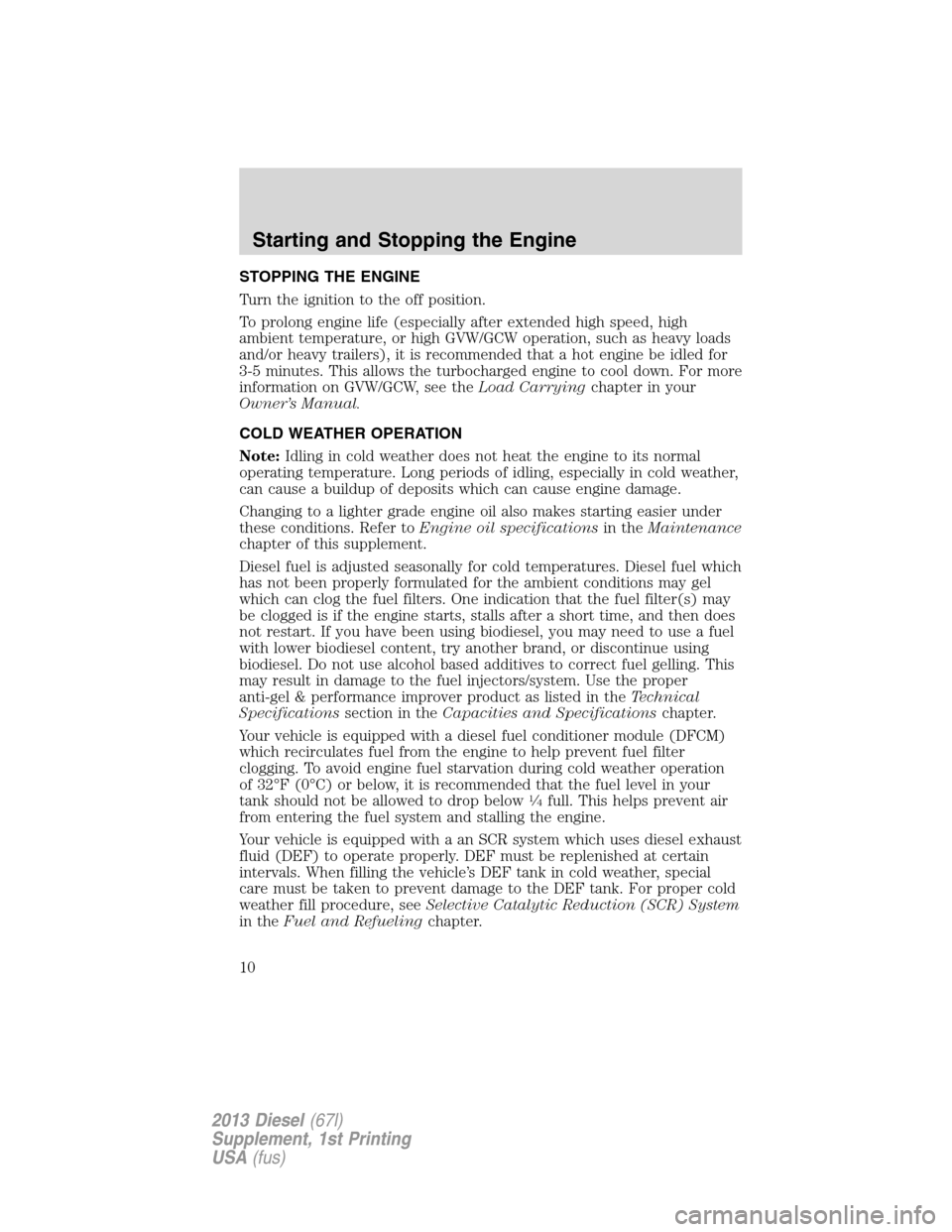
STOPPING THE ENGINE
Turn the ignition to the off position.
To prolong engine life (especially after extended high speed, high
ambient temperature, or high GVW/GCW operation, such as heavy loads
and/or heavy trailers), it is recommended that a hot engine be idled for
3-5 minutes. This allows the turbocharged engine to cool down. For more
information on GVW/GCW, see theLoad Carryingchapter in your
Owner’s Manual.
COLD WEATHER OPERATION
Note:Idling in cold weather does not heat the engine to its normal
operating temperature. Long periods of idling, especially in cold weather,
can cause a buildup of deposits which can cause engine damage.
Changing to a lighter grade engine oil also makes starting easier under
these conditions. Refer toEngine oil specificationsin theMaintenance
chapter of this supplement.
Diesel fuel is adjusted seasonally for cold temperatures. Diesel fuel which
has not been properly formulated for the ambient conditions may gel
which can clog the fuel filters. One indication that the fuel filter(s) may
be clogged is if the engine starts, stalls after a short time, and then does
not restart. If you have been using biodiesel, you may need to use a fuel
with lower biodiesel content, try another brand, or discontinue using
biodiesel. Do not use alcohol based additives to correct fuel gelling. This
may result in damage to the fuel injectors/system. Use the proper
anti-gel & performance improver product as listed in theTechnical
Specificationssection in theCapacities and Specificationschapter.
Your vehicle is equipped with a diesel fuel conditioner module (DFCM)
which recirculates fuel from the engine to help prevent fuel filter
clogging. To avoid engine fuel starvation during cold weather operation
of 32°F (0°C) or below, it is recommended that the fuel level in your
tank should not be allowed to drop below
1�4full. This helps prevent air
from entering the fuel system and stalling the engine.
Your vehicle is equipped with a an SCR system which uses diesel exhaust
fluid (DEF) to operate properly. DEF must be replenished at certain
intervals. When filling the vehicle’s DEF tank in cold weather, special
care must be taken to prevent damage to the DEF tank. For proper cold
weather fill procedure, seeSelective Catalytic Reduction (SCR) System
in theFuel and Refuelingchapter.
Starting and Stopping the Engine
10
2013 Diesel(67l)
Supplement, 1st Printing
USA(fus)
Page 20 of 95
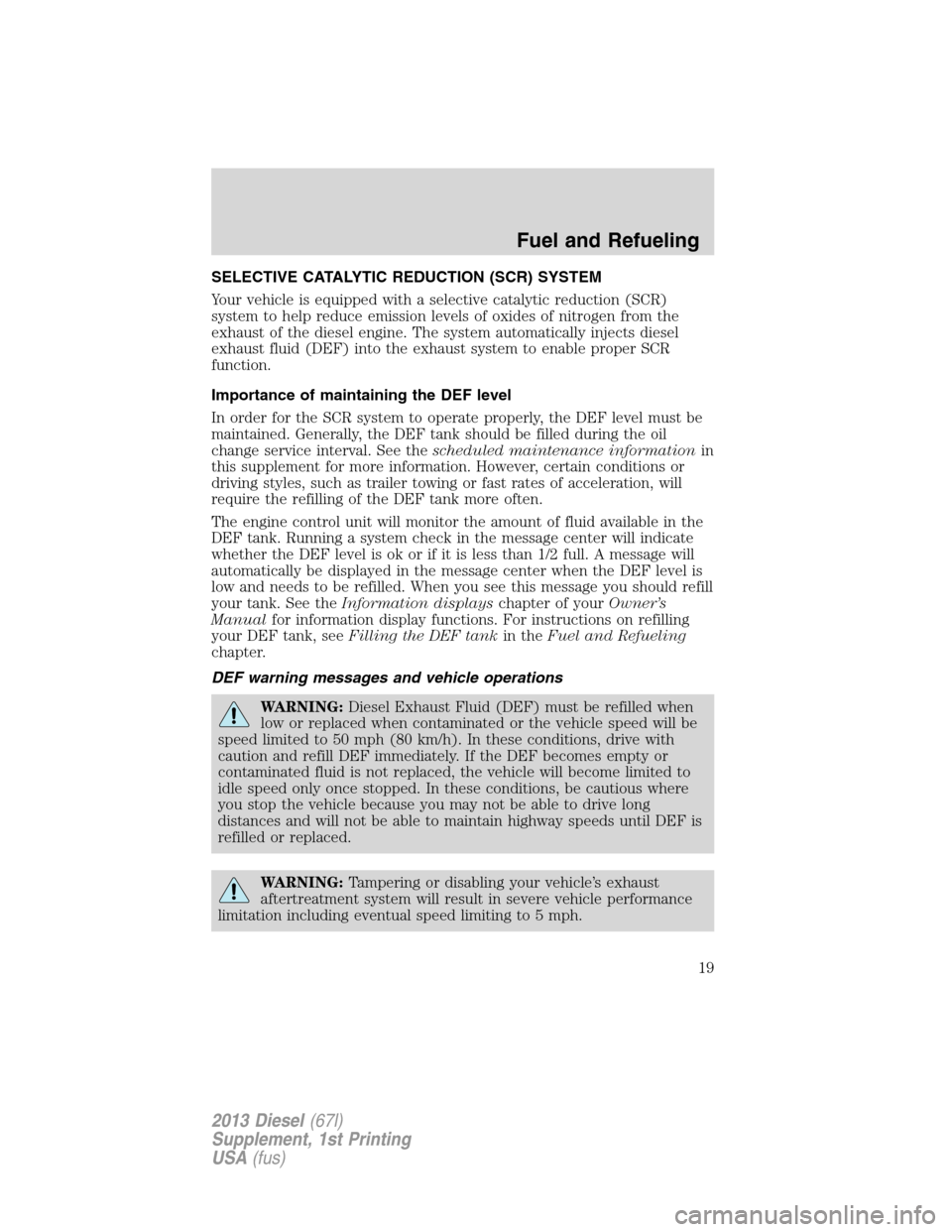
SELECTIVE CATALYTIC REDUCTION (SCR) SYSTEM
Your vehicle is equipped with a selective catalytic reduction (SCR)
system to help reduce emission levels of oxides of nitrogen from the
exhaust of the diesel engine. The system automatically injects diesel
exhaust fluid (DEF) into the exhaust system to enable proper SCR
function.
Importance of maintaining the DEF level
In order for the SCR system to operate properly, the DEF level must be
maintained. Generally, the DEF tank should be filled during the oil
change service interval. See thescheduled maintenance informationin
this supplement for more information. However, certain conditions or
driving styles, such as trailer towing or fast rates of acceleration, will
require the refilling of the DEF tank more often.
The engine control unit will monitor the amount of fluid available in the
DEF tank. Running a system check in the message center will indicate
whether the DEF level is ok or if it is less than 1/2 full. A message will
automatically be displayed in the message center when the DEF level is
low and needs to be refilled. When you see this message you should refill
your tank. See theInformation displayschapter of yourOwner’s
Manualfor information display functions. For instructions on refilling
your DEF tank, seeFilling the DEF tankin theFuel and Refueling
chapter.
DEF warning messages and vehicle operations
WARNING:Diesel Exhaust Fluid (DEF) must be refilled when
low or replaced when contaminated or the vehicle speed will be
speed limited to 50 mph (80 km/h). In these conditions, drive with
caution and refill DEF immediately. If the DEF becomes empty or
contaminated fluid is not replaced, the vehicle will become limited to
idle speed only once stopped. In these conditions, be cautious where
you stop the vehicle because you may not be able to drive long
distances and will not be able to maintain highway speeds until DEF is
refilled or replaced.
WARNING:Tampering or disabling your vehicle’s exhaust
aftertreatment system will result in severe vehicle performance
limitation including eventual speed limiting to 5 mph.
Fuel and Refueling
19
2013 Diesel(67l)
Supplement, 1st Printing
USA(fus)
Page 29 of 95

•Store DEF out of direct sunlight and in temperatures between 23°F
(-5°C) — 68°F (20°C).
•DEF will freeze below 12°F (-11°C).
•Do not store DEF bottle in vehicle. If it leaks it could cause damage to
interior components or release an ammonia odor inside the vehicle.
•DEF is non-flammable, non-toxic, colorless and water-soluble liquid.
•Do not dilute DEF with water or any other liquid.
•An ammonia odor may be smelled when the cap is removed or during
refill. Refill DEF in a well ventilated area.
Typical Diesel Exhaust Fluid (DEF) Usage
The charts below illustrateapproximateDEF usage for the given
distances traveled under various driving conditions and when using the
PTO. Your usage may vary depending on: driving style, trailer towing,
loaded vehicle weight, weather, idle time, PTO usage, etc.
Pick-up (3.31 axle ratio)
Driving
styleTrailer towing /
aggressive or city
drivingNormal drivingSteady highway
driving
DEF
usage4100 miles
(6598 km) –
7100 miles
(11426 km)7100 miles
(11426 km) –
9600 miles
(15450 km)9600 miles
(15450 km) –
10000 miles
(16093 km) +
Pick-up (3.55 axle ratio)
Driving
styleTrailer towing /
aggressive or city
drivingNormal drivingSteady highway
driving
DEF
usage2800 miles
(4506 km) –
5800 miles
(9334 km)5800 miles
(9334 km) –
8100 miles
(13036 km)8100 miles
(13036 km) –
9700 miles
(15611 km)
Fuel and Refueling
28
2013 Diesel(67l)
Supplement, 1st Printing
USA(fus)
Page 30 of 95
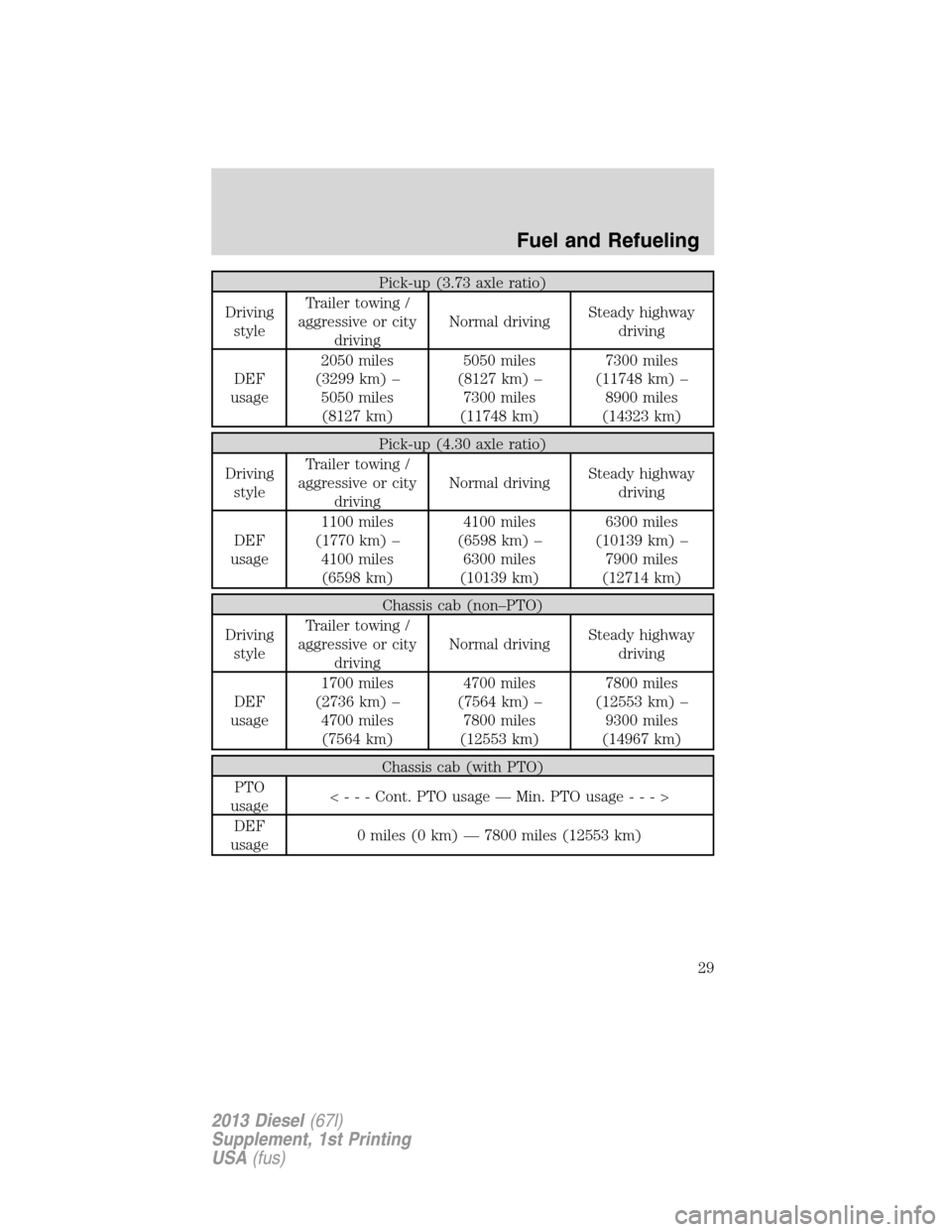
Pick-up (3.73 axle ratio)
Driving
styleTrailer towing /
aggressive or city
drivingNormal drivingSteady highway
driving
DEF
usage2050 miles
(3299 km) –
5050 miles
(8127 km)5050 miles
(8127 km) –
7300 miles
(11748 km)7300 miles
(11748 km) –
8900 miles
(14323 km)
Pick-up (4.30 axle ratio)
Driving
styleTrailer towing /
aggressive or city
drivingNormal drivingSteady highway
driving
DEF
usage1100 miles
(1770 km) –
4100 miles
(6598 km)4100 miles
(6598 km) –
6300 miles
(10139 km)6300 miles
(10139 km) –
7900 miles
(12714 km)
Chassis cab (non–PTO)
Driving
styleTrailer towing /
aggressive or city
drivingNormal drivingSteady highway
driving
DEF
usage1700 miles
(2736 km) –
4700 miles
(7564 km)4700 miles
(7564 km) –
7800 miles
(12553 km)7800 miles
(12553 km) –
9300 miles
(14967 km)
Chassis cab (with PTO)
PTO
usage<---Cont. PTO usage — Min. PTO usage--->
DEF
usage0 miles (0 km) — 7800 miles (12553 km)
Fuel and Refueling
29
2013 Diesel(67l)
Supplement, 1st Printing
USA(fus)
Page 46 of 95
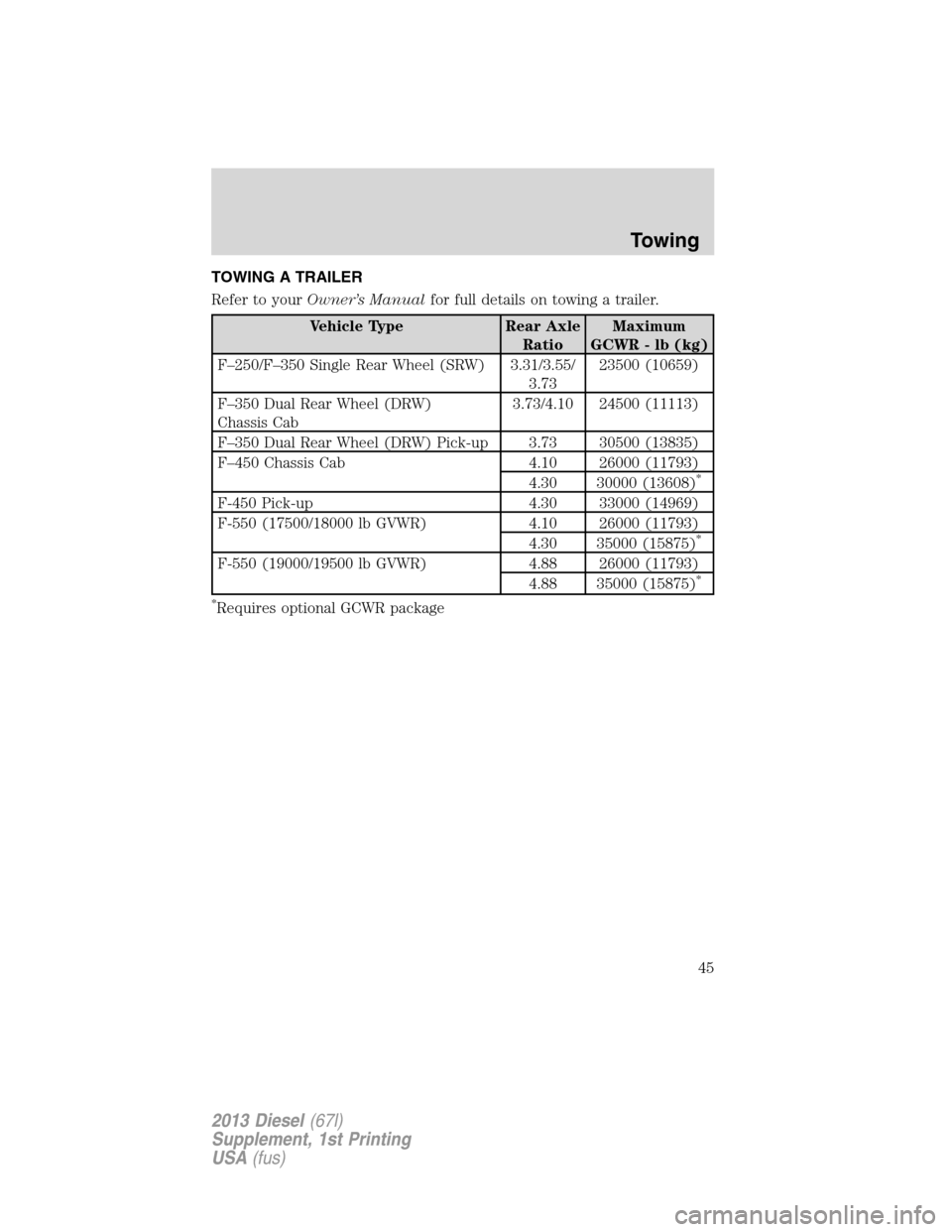
TOWING A TRAILER
Refer to yourOwner’s Manualfor full details on towing a trailer.
Vehicle Type Rear Axle
RatioMaximum
GCWR - lb (kg)
F–250/F–350 Single Rear Wheel (SRW) 3.31/3.55/
3.7323500 (10659)
F–350 Dual Rear Wheel (DRW)
Chassis Cab3.73/4.10 24500 (11113)
F–350 Dual Rear Wheel (DRW) Pick-up 3.73 30500 (13835)
F–450 Chassis Cab 4.10 26000 (11793)
4.30 30000 (13608)
*
F-450 Pick-up 4.30 33000 (14969)
F-550 (17500/18000 lb GVWR) 4.10 26000 (11793)
4.30 35000 (15875)
*
F-550 (19000/19500 lb GVWR) 4.88 26000 (11793)
4.88 35000 (15875)*
*
Requires optional GCWR package
Towing
45
2013 Diesel(67l)
Supplement, 1st Printing
USA(fus)
Page 53 of 95
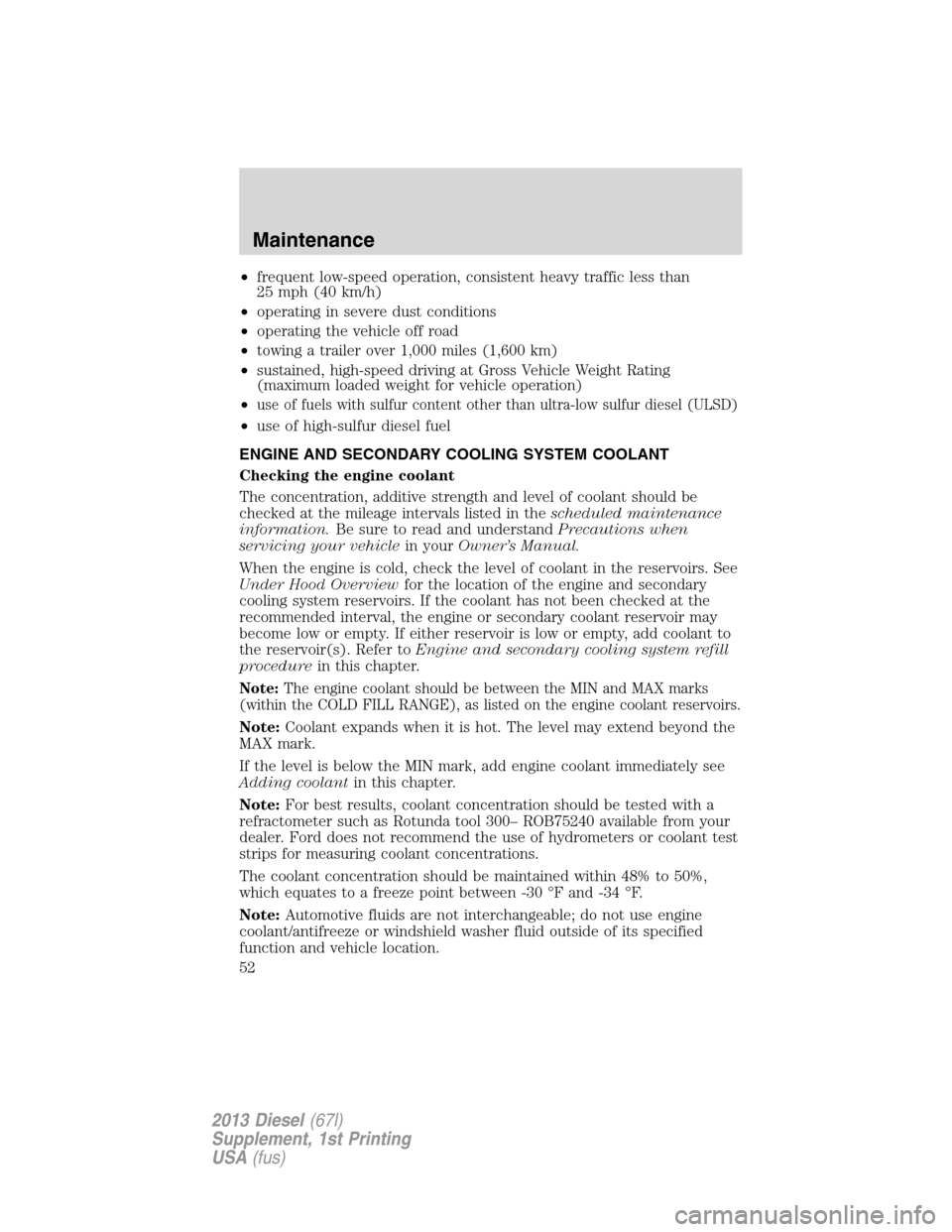
•frequent low-speed operation, consistent heavy traffic less than
25 mph (40 km/h)
•operating in severe dust conditions
•operating the vehicle off road
•towing a trailer over 1,000 miles (1,600 km)
•sustained, high-speed driving at Gross Vehicle Weight Rating
(maximum loaded weight for vehicle operation)
•
use of fuels with sulfur content other than ultra-low sulfur diesel (ULSD)
•use of high-sulfur diesel fuel
ENGINE AND SECONDARY COOLING SYSTEM COOLANT
Checking the engine coolant
The concentration, additive strength and level of coolant should be
checked at the mileage intervals listed in thescheduled maintenance
information.Be sure to read and understandPrecautions when
servicing your vehiclein yourOwner’s Manual.
When the engine is cold, check the level of coolant in the reservoirs. See
Under Hood Overviewfor the location of the engine and secondary
cooling system reservoirs. If the coolant has not been checked at the
recommended interval, the engine or secondary coolant reservoir may
become low or empty. If either reservoir is low or empty, add coolant to
the reservoir(s). Refer toEngine and secondary cooling system refill
procedurein this chapter.
Note:The engine coolant should be between the MIN and MAX marks
(within the COLD FILL RANGE), as listed on the engine coolant reservoirs.
Note:Coolant expands when it is hot. The level may extend beyond the
MAX mark.
If the level is below the MIN mark, add engine coolant immediately see
Adding coolantin this chapter.
Note:For best results, coolant concentration should be tested with a
refractometer such as Rotunda tool 300– ROB75240 available from your
dealer. Ford does not recommend the use of hydrometers or coolant test
strips for measuring coolant concentrations.
The coolant concentration should be maintained within 48% to 50%,
which equates to a freeze point between -30 °F and -34 °F.
Note:Automotive fluids are not interchangeable; do not use engine
coolant/antifreeze or windshield washer fluid outside of its specified
function and vehicle location.
Maintenance
52
2013 Diesel(67l)
Supplement, 1st Printing
USA(fus)
Page 59 of 95
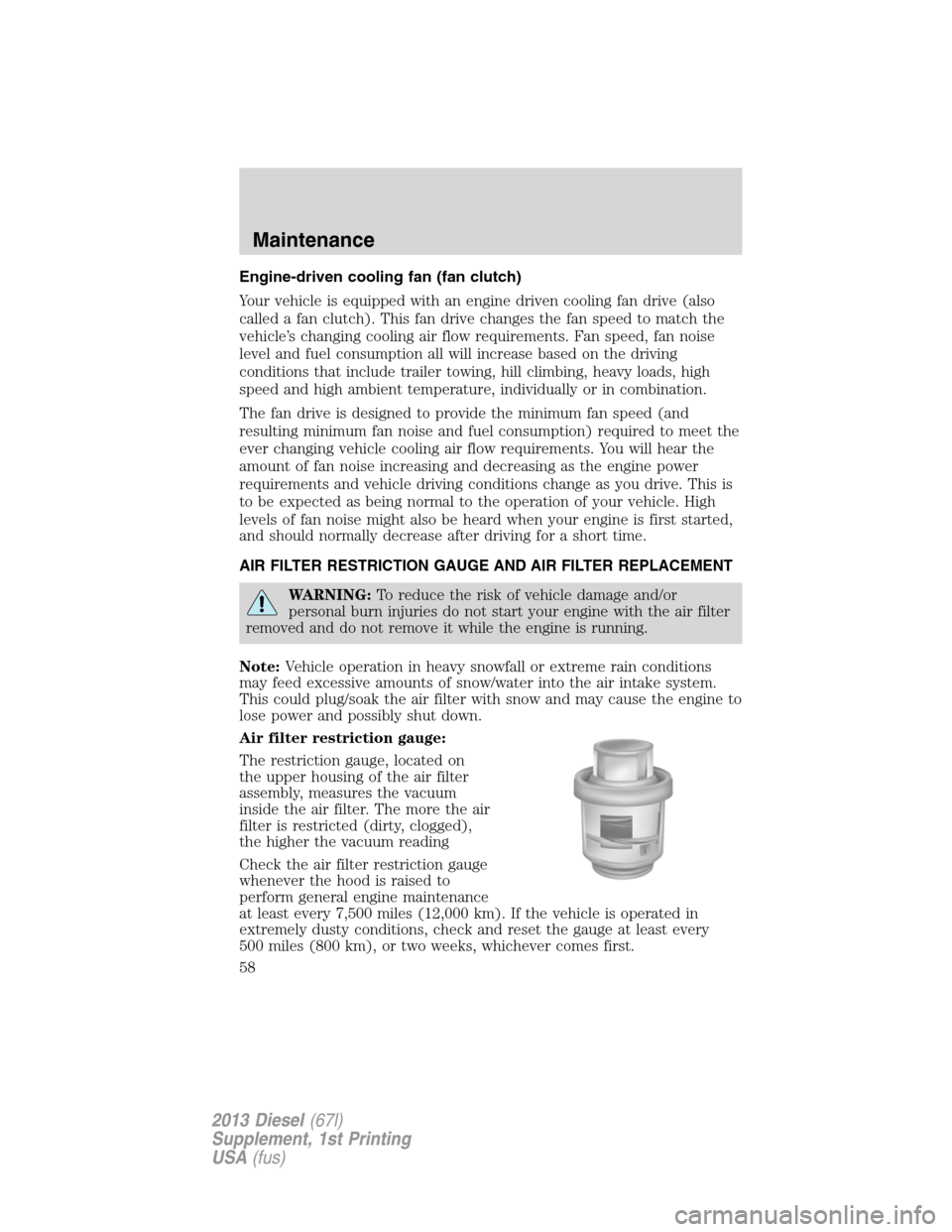
Engine-driven cooling fan (fan clutch)
Your vehicle is equipped with an engine driven cooling fan drive (also
called a fan clutch). This fan drive changes the fan speed to match the
vehicle’s changing cooling air flow requirements. Fan speed, fan noise
level and fuel consumption all will increase based on the driving
conditions that include trailer towing, hill climbing, heavy loads, high
speed and high ambient temperature, individually or in combination.
The fan drive is designed to provide the minimum fan speed (and
resulting minimum fan noise and fuel consumption) required to meet the
ever changing vehicle cooling air flow requirements. You will hear the
amount of fan noise increasing and decreasing as the engine power
requirements and vehicle driving conditions change as you drive. This is
to be expected as being normal to the operation of your vehicle. High
levels of fan noise might also be heard when your engine is first started,
and should normally decrease after driving for a short time.
AIR FILTER RESTRICTION GAUGE AND AIR FILTER REPLACEMENT
WARNING:To reduce the risk of vehicle damage and/or
personal burn injuries do not start your engine with the air filter
removed and do not remove it while the engine is running.
Note:Vehicle operation in heavy snowfall or extreme rain conditions
may feed excessive amounts of snow/water into the air intake system.
This could plug/soak the air filter with snow and may cause the engine to
lose power and possibly shut down.
Air filter restriction gauge:
The restriction gauge, located on
the upper housing of the air filter
assembly, measures the vacuum
inside the air filter. The more the air
filter is restricted (dirty, clogged),
the higher the vacuum reading
Check the air filter restriction gauge
whenever the hood is raised to
perform general engine maintenance
at least every 7,500 miles (12,000 km). If the vehicle is operated in
extremely dusty conditions, check and reset the gauge at least every
500 miles (800 km), or two weeks, whichever comes first.
Maintenance
58
2013 Diesel(67l)
Supplement, 1st Printing
USA(fus)